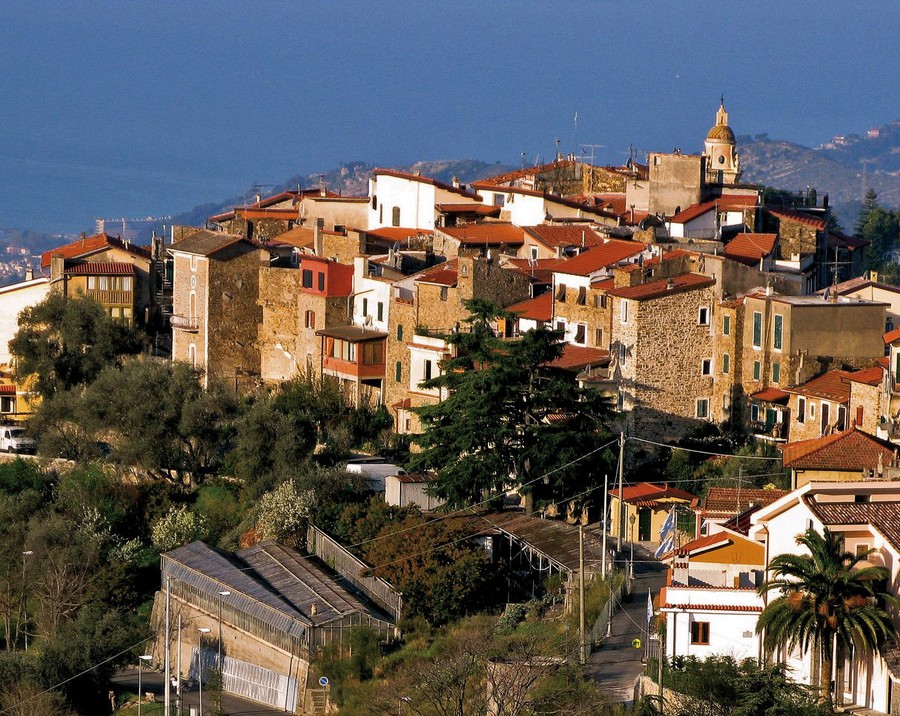Altitude: 516 m a.s.l.
Area: 8 sq km
Distance from Imperia: 43 km
Inhabitants: in 1881: 339 - in 2017: 307
Patron Saint Day: August 20th - S. Bernardo
Principality Day: November 11th - San Martino
Information: Municipality phone 0184 223622
The current name "Seborga" is of modern origin as it is mentioned for the first time in the official deed of sale of the area by the monks of Lerins to the king of Sardinia in 1729.
In a document dating back to 814 the generic Castrum was identified for the first time with the addition of the genitive Sepulchri with clear reference to a cemetery, a name that can be explained by the fact that the castrum was chosen by the Counts of Ventimiglia as a place intended to the burial of their dead in order to preserve them from the raids that at that time were carried out by the Saracens on the coastal locations.
On this occasion, the abbot prior of the Abbey took the title of "Prince of Seborga", of which "Prince George I" decorates himself today. It was also assumed that there was a relationship between the Holy Sepulcher and the town, but it remains a hypothesis in any case unlikely since the donation precedes the first Crusade by a century and a half.
Announced by repeated references to its "Principality", Seborga, formerly "Sepulchri burgum" (hence the name) of the Counts of Ventimiglia, was ceded by them to the monks of Lerins in 959.
The history of the "Principality" is linked to the great bluff of the abbot of Lerins, who around the year 1000 began to call himself "Prince" and promoted his village to Principality, which to tell the truth dragged on for centuries in general indifference.
In the second half of the seventeenth century, Seborga had just twenty families, all of which, except for two, were described as "poor and miserable"; nevertheless the enterprising monks even put up a mint, and the self-declared Principality began to coin its own currency; and even this initiative would not bother anyone if it hadn’t been that, exactly since the friars of Seborga began to mint coins, false gold coins started to circulate more and more often in neighboring France, so well counterfeit to make everyone think of real coinage professionals.
Rightly or wrongly, King Louis XIV argued with the Seborga mint, and had it closed in 1686.
Once the abundance was over, the monks left and in 1729 they sold their "Principality" to the Savoys, who were always ready to buy at any price every piece of land that could bring them closer to the sea.
Visit of the town
Parked the car on the widening, enter the village through via Miranda and, after crossing the nice little square, pass the butcher shop which still uses the well-restored window-door of an ancient shop and take the right on Via Verdi, pass under the vault and go down left on Vicolo Stretto, arriving into the cute little square, which is the churchyard of the Baroque church of San Martino decorated on the façade with frescoes of 1928.
There also rises, surrounded by the well-reconstructed loggia, the residential palace of the "prince", with a stucco from 1896 that reproduces his coat of arms.
The church was the chapel of the Benedictines and was completely rebuilt in the seventeenth century, a period of which two wooden statues are preserved inside: to the right that of the saint and behind the high altar the one, of Spanish origin, of the Virgin with Child.
Leaving the church, go down to the right and, after arriving to the open space where the Town Hall is located, go up the ramp with the first semi-circular steps in front of it: passing under the vault you’ll find the real most humble and genuine Seborga, that is hidden in its darkest alleys, with its old stones.
After the vault take the left and return to the already walked street till you reach the car; on the mountain side of the clearing from which you will be descending down stands the oratory of San Bernardo, originally of the thirteenth century but entirely rebuilt in Baroque style. In the absence of a bell tower the bell hangs on the left side.
Return to the Aurelia and proceed towards Vallecrosia.


